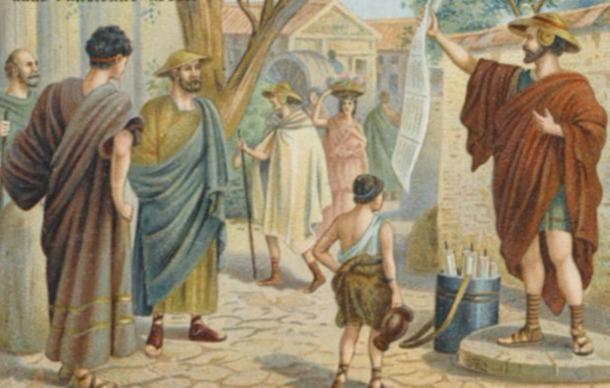
Ancient Samos and the Museum of Mysterious Artifacts
The island of Samos in Greece is an island about 1.5 km from the shores of Turkey, which has a long history dating back to 4,000 BC. The name ‘Samos’ is thought to have Phoenician origin and according to the ancient Greek geographer Strabo, the name means ‘altitude near the coast’, probably because of the high mountains on the island. Samos was a very important island in ancient times, and the historian Herodotus referred to it as the best city among both the Greeks and the ‘Barbarians’.
There are many myths in relation to the origins of the island. According to legend, sea nymphs or Nereids were the first inhabitants of the island. Nereids were deities that accompanied the god Poseidon and helped sailors to fight the storms and travel safely on the sea waters. One famous Nereid was the mother of Achilles, Thetis.
- The Tunnel of Eupalinos: One of the Greatest Engineering Achievements of the Classical World
- Qanat Furan, The Most Spectacular Underground Aqueduct of The Ancient World

Pelasgians of Samos Island (Archivist / Adobe Stock)
The first inhabitants of Samos island were the Pelasgians who are considered to be ancestors of the Greeks. According to Greek mythology, the first king of Samos Island was said to be the demigod king Ancaeus (Ankaios), son of the god Poseidon and Astypalaea. Ancaeus was also one of the heroes in the Argonauts who accompanied Jason on the quest in search of the Golden Fleece.
The Goddess Hera was the protector of the island, who according to mythology was born on Samos Island. Another important figure of Samos is the Greek philosopher and mathematician, Pythagoras.
As we can see, Samos Island has an important place in ancient Greek mythology. The significance of the island is also reflected in the museums of the main city, which contain a wide range of very impressive artifacts. The first archaeological excavations took place in 1812 with British archaeologists from London and then continued with the Germans in 1900.
The artifacts reflect the importance of the island as a cultural centre in ancient times. The influence of the Minoan, Mycenaean, Egyptian, and Mesopotamian civilizations is depicted in the artifacts found during the archaeological excavations.
According to the museum, the strange bronze artifact shown in the featured image (above) depicts a carriage that would have been pulled by horses. However, there are a few interesting features of the image: a) the figurines have a very unusual appearance including pointed faces and unusually long necks, b) the shape of the object they are placed upon bears no similarity to a carriage (it looks a lot more like a submarine!), and c) the figurine on the left has something connected to the waist which he also holds, like some kind of wheel or control.
Another unique item is a bronze artifact depicting naked female figurines, which was given as a gift to the ruler Azael of the Old Testament. The text is written in Aramaic, and the origin of the artifact is believed to be from Syria in about the 7th century BC, hence the similarities with ancient Sumerian depictions of the sun god on the top.
- Pythagoras the Hermit: the Pythagoras Cave on Samos
- More than a Sip and You Feel a Drip: A Morbid Motif for the Crafty Pythagoras Cup

Bronze artifact depicting naked female figurines. (ΣΑΜΟΣ: Τα αρχαιολογικά μουσεία – Ίδρυμα Λάτση (GR))
In addition to the unique and fascinating artifacts, Samos is also home to one of the greater architectural achievements of ancient Greece – an aqueduct commissioned by the architect and engineer Eupalinos in the 6th century BC, a one-kilometer (0.62 mi) tunnel which was able to transfer more than 400 cubic meters of water per day. Being the longest tunnel of its time, the tunnel is regarded as a major feat of ancient engineering. The Greek historian Herodotus described the tunnel briefly:
“I have dwelt rather long on the history of the Samians because theirs are the three greatest works of all the Greeks. One is a tunnel through the base of a nine hundred foot high mountain. The tunnel's length is seven stades, its height and length (width) both eight feet. Throughout its length another cutting has been dug three feet wide and three feet deep, through which the water flowing in pipes is led into the city from an abundant spring.”

The aqueduct of Eupalinos. (ΣΑΜΟΣ: Τα αρχαιολογικά μουσεία – Ίδρυμα Λάτση (GR))
The aqueduct of Eupalinos and the Museum of Samos are definitely worth a visit. The island of Samos holds a significant place in both history and mythology. From its early Pelasgian inhabitants to its mythological ties to Poseidon, Hera, and Pythagoras, the island has been a vital cultural and religious center. The impressive archaeological finds, including unique bronze artifacts and the engineering marvel of the Eupalinos tunnel, showcase the island's ancient importance. Samos was not only a hub for Greek civilization but also influenced by various cultures like the Minoans, Mycenaeans, and Egyptians. Today, the island’s rich history continues to captivate visitors through its well-preserved museums and historical landmarks.
Below are some more images showing some of the unique artifacts found on the island.

Left; A goat-like creature with wings. It was part of a handle of some kind of a bowl. Right; A figurine with influences of the Minoan Civilization.(ΣΑΜΟΣ: Τα αρχαιολογικά μουσεία – Ίδρυμα Λάτση (GR))

One of the oldest Egyptian goddesses, Nut, mother of Osiris, is on the right and Syrian god Resheph is believed to be the figure on the left – god of plagues and war. (ΣΑΜΟΣ: Τα αρχαιολογικά μουσεία – Ίδρυμα Λάτση (GR))
By John Black
This article was first published in Feb 2014 and was updated Nov 2024.
References
Ancient Samos. Available at: https://meandertravel.com/samos/samos.php?details=historyofsamos1
History of Samos. Available at: https://www.greece.org/
ΣΑΜΟΣ: Τα αρχαιολογικά μουσεία – Ίδρυμα Λάτση (GR)














